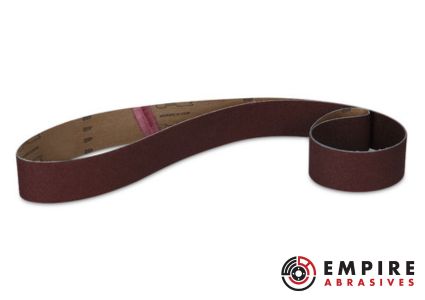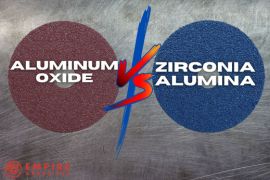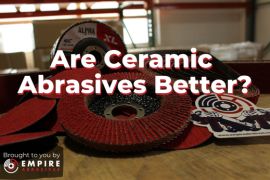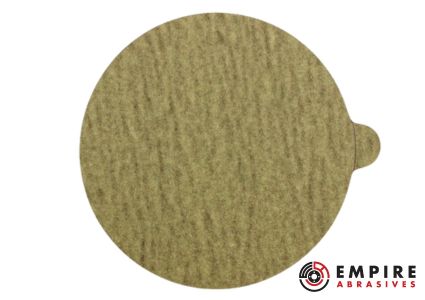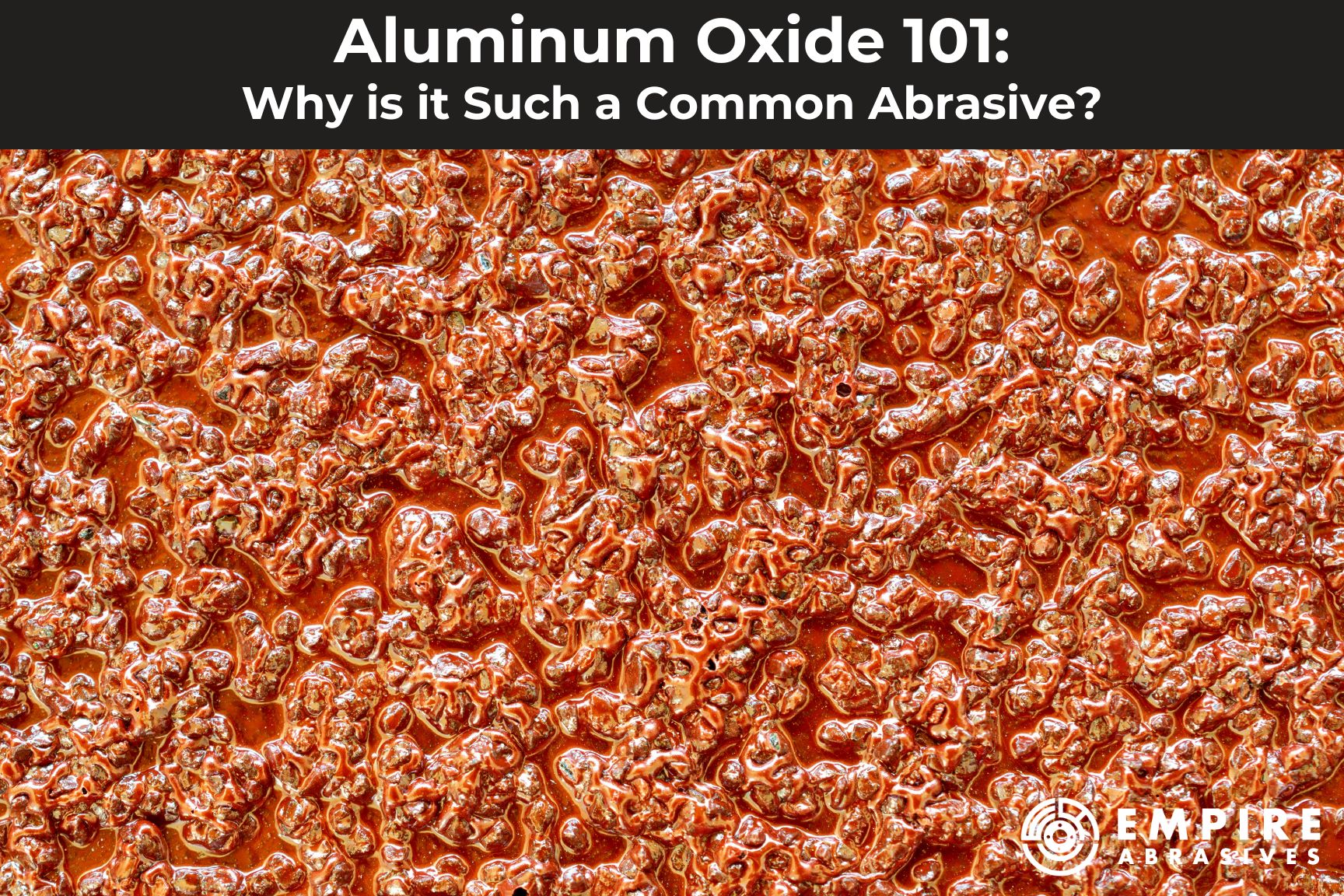
From metalworking and fabrication to woodworking and auto body work, aluminum oxide has become the most used abrasive grain thanks to its unique blend of properties. In this guide, we'll explore everything you ever wanted (and probably more than you ever wanted) to know about aluminum oxide abrasives. Whether you're a long-time professional or just starting out with abrasive products, this article will provide an in-depth education on this amazing abrasive grain.
What is Aluminum Oxide?
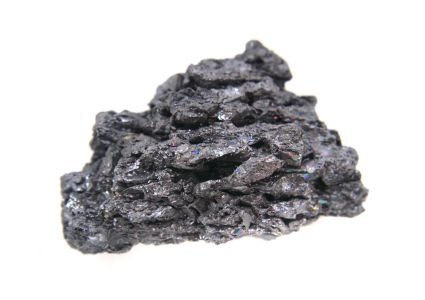
Sciencey talk - aluminum oxide (also known as corundum or alumina) is an inorganic compound made up of aluminum and oxygen with the chemical formula Al2O3. It exists naturally in a crystalline form known as the corundum, but is also synthesized for industrial use through the Bayer process or nitrogen plasma synthesis. During manufacturing, aluminum oxide is fused into crystalline structure in irregular shaped grains/grits that can then be incorporated into various abrasive products
Less sciencey talk - Aluminum oxide is a durable and hard mineral used widely as an abrasive grain that is usually adhered to a coated abrasive or embedded into a bonded cutting or grinding product. Its crystalline structure mentioned in the sciencey talk above makes it particularly effective for sanding, grinding, and polishing.
Key Properties of Aluminum Oxide
Hardness:
Rating 9 on the Mohs hardness scale, AO is one of the toughest and most durable abrasive grains available - second only to diamond*. This hardness helps maintain its sharpness and also makes aluminum oxide suitable for a wide range of materials, including hard steels, alloys, and certain ceramics.
*Some forms of silicon carbide can approach the hardness of diamond and cubic boron nitride (CBN) is nearly as hard as a diamond. CBN is not a commonly used abrasive grain and is usually only used in highly specialized applications due to its high cost and various other limitations.
Toughness:
Abrasive toughness comes down to how much it can withstand impacts and resist fracturing before it ultimately breaks down during normal abrasive use. Aluminum oxide is in the middle of the pack of abrasive grains in terms of toughness, with a K1c value typically in the range of 4-6 MPa√m. It is tougher than silicon carbide, but more brittle than zirconia or ceramic. For many applications, it is in a sweet between toughness and brittleness. It is definitely resilient enough to handle high-pressure grinding and sanding tasks on most materials, and the brittleness becomes a benefit in terms of friability.
Friability:
Friability is an abrasive grain’s property associated with its tendency to break apart into smaller pieces. While that might sound like a bad thing, it is a benefit for some abrasives like aluminum oxide. Instead of having the sharp surface of the abrasive dull down through use, the grains break down under pressure, exposing fresh, sharp cutting edges. This self-sharpening characteristic has several benefits including helping maintain a consistent cutting rate and reducing workpiece heat build-up
Common Products with Aluminum Oxide
Aluminum oxide is so versatile and budget-friendly that it can be found in almost every type of consumer abrasive product. Below are a few of the commonly used product forms and types you’ll find with an option for alumina.
- Sanding Belts: Used on belt sanders for stock removal, blending, and finishing.
- Abrasive Discs: For angle grinders and other tools to sand, grind, and polish surfaces.
- Grinding Wheels: Used on stationary machines and portable grinders for stock removal, deburring, and shaping of metal, wood, and other materials.
- Cutoff Discs: Used on angle grinders, die grinders, and chop saws for cutting metal, masonry, concrete, and other materials.
- Sandpaper Sheets: Hand sanding or machine use, providing flexibility and precision.
- Non-wovens: Often in various forms with alumina sometimes embedded on the nylon, for surface finishing, light deburring, and cleaning.
Grit Sizes and Applications
Aluminum oxide grits/grains are manufactured in a range of sizes from very coarse (16 grit) to extra-extra fine (1200+ grit), each serving specific applications:
- Coarse grits (16-60) are used for heavy-duty stock removal, shaping, deburring on metals/wood
- Medium grits (80-180) are ideal for dimensioning, cleaning, descaling metals
- Fine grits (220-600) provide finish sanding, polishing, and prepping surfaces
- Superfine grits (800-1200+) create ultra-smooth, polished finishes on metal/wood
The specific grit size is selected based on factors like the starting material condition, workpiece rigidity, finish requirements, and material removal rate needed. Below is a more detailed grit chart you use as a general guideline.
Grit Chart - Aluminum Oxide Abrasives
These are general guidelines; actual use might require adjustments based on the exact material and desired finish.
| Grit Size |
Coarseness Level |
Common Applications |
Material Compatibility |
Wear Rate |
Notes |
| 24 - 36 | Very Coarse | Heavy stock removal, rust removal, rough shaping | Hard metals, rough wood | Wears down quickly | Generates significant heat, use with caution |
| 40 - 60 | Coarse | General purpose sanding, deburring, initial smoothing | Most metals, hardwoods | Moderate lifespan | Moderate heat generation |
| 80 - 120 | Medium | Intermediate smoothing, blending, surface prep for finishing | All woods, softer metals | Good wear resistance | Lower heat, good balance of removal and finish |
| 150 - 220 | Fine | Fine sanding, creating a smooth base for paint/coatings | Finishing most surfaces | Longer lasting | Very light material removal, focus on smoothness |
| 240 - 400 | Very Fine | Final finishing, polishing, very light material removal | Soft metals, plastics, delicate work | Excellent lifespan, best for extended tasks | Designed for smooth finishes |
| 600 + | Ultra-Fine | Ultra-fine polishing, honing, creating specific surface finishes | Very soft materials | Extremely long lifespan | Minimal removal, for refined finishes only |
Compared with other Abrasive Grains
Aluminum oxide isn’t the only abrasive on the block. While it is incredibly versatile, there are other choices you should consider depending on different applications and what materials are involved. Here's a quick comparison of aluminum oxide against other common abrasive grains:
Silicon Carbide
- Harder and runs hotter than aluminum oxide, better for aggressive stock removal
- More friable giving it a faster cut rate but shorter lifespan
- Ideal for ceramics, stone, glass, and hardened steels
- Can be used for wet sanding
Read more - Silicon Carbide vs Aluminum Oxide Abrasives
Zirconia Alumina
- Harder and sharper than standard aluminum oxide
- Superior damage resistance and heat dissipation
- Optimal for tough metals like stainless steel and titanium
Read more - Aluminum Oxide vs Zirconia Abrasives
Ceramic Alumina
- Advanced aluminum oxide grain with higher purity/density, for a higher cost
- Retains its shape better than standard aluminum oxide
- Offers cooler cutting, which would be better for heat-sensitive applications
- Can be used for wet sanding
Read more - Are Ceramic Abrasives Better?
Material Compatibility
Another reason aluminum oxide is used so much as an abrasive grain is that it is compatible with so many different surfaces. It’s capable of sanding, grinding, or polishing most metal, wood, and composite surfaces including:
Ferrous Metals (Steel, Iron, etc.)
The hardness and resilience of aluminum oxide make it excellently suited for grinding, sanding, and finishing ferrous metals. It can withstand the high pressures and heat caused by grinding these metals without dulling too quickly.
Non-Ferrous Metals (Aluminum, Brass, etc.)
The same properties that work well on steel translate to its work on non-ferrous metals too. Aluminum oxide's hardness allows it to efficiently cut and finish these softer metals with minimal loading (clogging).
Wood & Wood Composites
Aluminum oxide is one of the top abrasive choices for woodworking applications like sanding solid wood, plywood, MDF, and other wood-based materials. Its durability and sharp cutting edges make it great for shaping and smoothing wood surfaces.
Plastics & Composites
Aluminum oxide can be used on fiberglass and other composite materials. It can also sand certain types of plastics, such as acrylic, polycarbonate, and PVC.
When NOT to use Aluminum Oxide
Aluminum oxide is great for the materials above, but there are some instances where we don’t recommend using it.
- Very hard materials: Silicon carbide may be a better choice for certain hardened steels or ceramics.
- Extremely heavy-duty use: Zirconia or ceramic alumina will outlast aluminum oxide significantly.
You can still use aluminum oxide for those materials, but it will likely take longer to do and dull the grains faster than you’ll be happy with.
Why Choose Aluminum Oxide?
Aluminum oxide has many advantages over other abrasives including:
- Cost-Effectiveness: It is generally less expensive than most of the other abrasive grains, especially specialized ones like ceramic alumina.
- Versatility: One of aluminum oxide's biggest advantages is its versatility. It can be used on a variety of surfaces, from metals to woods, and for different processes including grinding, deburring, and finishing.
- Longevity: Aluminum oxide is a tough material that resists wearing down. Abrasives made from aluminum oxide often last longer than those made from softer materials.
- Performance: Known for its durable nature, aluminum oxide maintains a sharp cutting edge longer than many other abrasive materials.
- Availability: As one of the most common abrasive grains, aluminum oxide products are widely available in a variety of forms and most grits.
Common Aluminum Oxide Uses
In industries like metalworking, welding & fabrication, knife making, and woodworking, aluminum oxide is a go-to abrasive for everything from initial cutting and grinding to final sanding and buffing. A few common applications include:
- Grinding Metal: Aluminum oxide grinding wheels are commonly used for aggressive material removal and are often used to grind welds, shape metal parts, and sharpen tools.
- Surface Finishing: Aluminum oxide sandpapers and finishing discs are used to achieve fine finishes from woodworking to auto body repair.
- Deburring: After machining operations, aluminum oxide abrasive discs or belts can be used to remove burrs that form on metal parts.
- Polishing: Aluminum oxide is often added into buffing and polishing compounds or used in buffing wheels to polish metal and wood surfaces to a high shine.
- Sandblasting: It is also a popular choice as a media for sandblasting operations.
Innovative Aluminum Oxide Technologies
While aluminum oxide has been used for decades, there are also cutting-edge technologies improving its performance that you can find in Empire Abrasives’ products:
Heat-Treated Aluminum Oxide
Manufactured using special heat-treating processes, the crystalline structure and hardness of the aluminum oxide grains can be enhanced. This increase in hardness creates grains with sharper cutting edges that are able to achieve faster, more aggressive material removal rates compared to untreated grains.
Empire Abrasives Example: Our 8” cloth backed sanding discs and circular saw cutting discs are made with heat-treated AO for tackling tough jobs.
Gold Stearate Coating
Some abrasive products have a special coating added to it, made up of microscopic layers of gold stearate - a salt lubricant. It reduces friction when sanding, which generates less heat. Too much heat when grinding a surface can lead to burnt/damaged workpieces. Products with this coating are a favorite among auto body workers and woodworkers since it also reduces clogging when working with wood or other gummy materials.
Empire Abrasives Example: Many of our hook and loop sanding discs and continuous roll longboard paper feature stearate coatings.
Browse Our Catalog Today
Now that you know more than you asked to know about aluminum oxide abrasives, check out our wide ranging selection today. Remember, we ship out most orders by the next business day—start shopping now to get your abrasives ASAP!
Still need help choosing the right grit or product type? Feel free to contact our abrasives experts by phone, online chat, or email.

